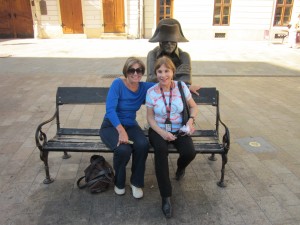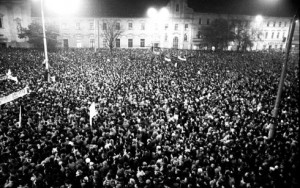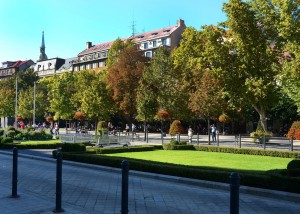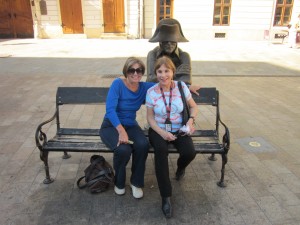When Martin Sloboda was sixteen years old, he gathered, with the thousands of protesters pictured above, in SNP Square in Bratislava, Czechoslovakia. It was November 17, 1989, the night before International Students Day, which, that year, commemorated the 50th anniversary of the death of Jan Opletal, a Czech medical student. During World War Two, the martyred Opleta, who was participating in a student peace march, was shot seven times by the Nazis. Following that protest, the German occupiers reacted by ransacking the dormitories, shuttering universities, executing nine students and sending over one thousand students and professors to concentration camps.
Fifty years later, Sloboda, along with other Bratislava high school and university students, organized a peaceful demonstration in the center square. If you remember, after the Nazi loss, the Russians triumphed, taking over the country and ruling it with a hammer and sickle . That there was an assembled crowd at all was a big no-no in Iron Curtain countries. The local Communist Party’s armed forces were put on alert while the students moved somewhat peacefully through the city.
With local street protests increasing in size, along with the collapse of other Warsaw Pact governments, the Czech Communist Party relinquished power and dismantled the single-party state. To the Czechs, the November 17-December 29, 1989, revolution is called the Velvet Revolution.The Slovaks prefer the name, Gentle Revolution (nežná revolúcia). Whatever your choice, within six weeks, Czechoslovakia joined other eastern and central Europe in freeing themselves from Communist domination.
What is even more astounding is three years after the revolution Czechoslovakia split peacefully into two countries, the Czech Republic and Slovakia.
Do You Remember 1989? George H.W. Bush was President. “Seinfeld: premiered on television. Slugger Pete Rose agreed to a lifetime ban from baseball. A Friday the 13th mini-crash brought the Dow tumbling to 2569.26. The Berlin Wall fell. Nintendo’s “Game Boy” was released in North America. “Breathing Lessons” by Anne Tyler won the Pulitzer Prize for Fiction. Mikhail Gorbachev was named the Time Man of the Decade. The Last Soviet Union armored column left Kabul, ending 9 years of military occupation. We Baby Boomers were in our mid-40s. The first Global Positioning System satellites were placed into orbit. The Exxon Valdez oil spill was a disaster. “Rain Man” won the Academy Award for best film. Protests began in Tiananmen Square. The post-Cold War Period, characterized by American dominance in world affairs, began.
Today, the 37-year old Sloboda, who has a wife and two children, lives in Bratislava, belongs to Rotary, joined “Linkedin” recently and owns a Leisure, Travel & Tourism Business. He is an author, guide, photographer, lecturer, travel consultant and event coordinator, focusing on promoting Slovakia as an attractive tourist destination. In 2007, during the European Union’s 50th Anniversary in Berlin, Sloboda was selected into the European Union Panorama of ” 27 True Europeans” representing Slovakia among 27 member states.
I met this young Slovakian entrepreneur when he addressed our touring group during a day’s visit in Bratislava, the capital city. No longer a “freedom fighter”, although he had taken his share of abuse during the Soviet occupation, Sloboda, casually dressed in a polo shirt and blue jeans, spoke perfect English and was bursting with pride over his country’s progress the past 18 years since the Czech/Slovak split.
“Were we scared?”, he said, replying to a question from his audience.
Although noting that the student demonstrators in Prague were severely beaten back by riot police, he shrugged, adding, “Nah. We were kids. We were invincible.”
Reminiscing that his grandparents survived Nazism and his parents and siblings lived under Communism, he admitted, as a youth, to chafing at the restrictive lifestyle. “If things went wrong during these protests, we were putting not only ourselves but our families at risk,” he admits. “When we cut classes, our teachers knew where we were. Our parents even knew where we were. No one stopped us. I don’t think they could have stopped us”
Unwilling to dwell on the past, he’s eager to tout the virtues and strengths of Slovakia, a country that in 1997 was called by former Secretary of State Madeleine Albright, “the black hole in the heart of Europe.”
OUCH!
Those were fighting words to the Slovaks who, in 2004, joined the European Union and in 2009, because of their growing economic prowess, were invited to adopt the Euro currency, beating “bigger bordering brothers”, Hungary, Poland and the Czech Republic who still use the forint, zloty and koruna. Therefore, this tiny land-locked country of 5.5 million, the second-poorest in the Euro Zone, sits at the table with a vote as powerful as the other 16 members, including France and Germany.
When I was in Slovakia, the jury was still out on whether their government was going to approve, like the other 16 EU members, a collective EU bailout fund to guarantee the debt of their richer neighbors like Greece, Spain and Italy. Although the Slovakian parliament did eventually pass the measure, the Slovakian people are outraged.
Nicholas Kulish, an International Herald Tribune reporter, relates the following:
In a television advertisement for the popular Slovak beer, Alzty Bazant, a grinning Greek man with a paunch stands on a sunny beach, nodding his head, as the narrator says, “To want to borrow from everyone: That is Greek.” The ad then cuts to a skinny Slovak man, standing in a field, who shakes his head back and forth. “To not want to lend to anyone,” the narrator says, “That is Slovak.”
Is it just me or does much of this sound familiar?






I luv this…u captured the spirit, history and culture via a young person living thru it. Bravo